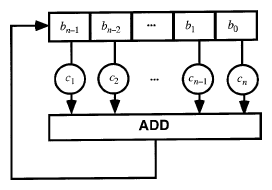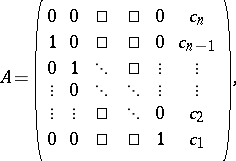Shift register sequence
recursive sequence, recurrent sequence
A sequence which can be obtained as the output of a linear feedback shift register. The term "shift register sequence" stems from the engineering literature; in mathematics, the terms recursive sequence or recurrent sequence are more common. The classical reference on shift register sequences is [a1]; see also [a2] or [a3] for expositions.
A linear feedback shift register of length $n$ (LFSR) is a time-dependent device (running on a clock) of $n$ cells each capable of holding a value from some field $F$, such that with each clock cycle the contents of the cells are shifted cyclically by one position (to the right, say). While the LFSR discards (or outputs) the rightmost entry $b_0$ (and replaces it by $b_1$), it computes the linear function
\begin{equation}c_1b_{n-1}+...+c_nb_0\end{equation}
of the present state vector $(b_0,...,b_{n-1})$ and the feedback coefficients $(c_1,...,c_n)$, see Fig.a1. Thus, the box with the entry "ADD" stands for an adder over $F$, and the circle with entry $c_i$ indicates multiplication by $c_i\in F$. (The question of how this might be realized in hardware is not addressed here; see [a5], [a6].) In practice, the case of the binary field $\text{GF}(2)$ is by far the most important one, but the general notion of an LFSR serves as a good intuitive way of modelling recursive sequences.

Figure: s130270a
A linear feedback shift register
Given the initial conditions $(a_0,..,a_{n-1})$, after $t$ clock cycles the LFSR will hold the state vector $\mathbf{a}^{\langle t+1\rangle}=(a_t,..,a_{t+n-1})$, where
\begin{equation}a_{t+n-1}=c_1a_{t+n-2}+...+c_na_{t-1}\end{equation}
Thus, the shift register sequence $\mathbf{a}=(a_k)$ produced by the LFSR will satisfy a linear recurrence relation of order $n$; namely, for $k\geq n$:
\begin{equation}a_k=\sum^n_{i=1}c_ia_{k-i}\end{equation}
With the convention $c_0=-1$, one defines the feedback polynomial of the LFSR as
\begin{equation}f(x)=-c_0-...-c_nx^n\end{equation}
its reciprocal polynomial
\begin{equation}f^*(x)=x^n-c_1x^{n-1}-...-c_{n-1}x-c_n\end{equation}
is called the characteristic polynomial of the LFSR. Using its companion matrix
 |
the recursion (a2) can be rewritten in terms of the state vectors as
 |
 is usually called the feedback matrix of the LFSR, and it satisfies the equation
is usually called the feedback matrix of the LFSR, and it satisfies the equation  , where
, where  and
and  denote the characteristic and the minimal polynomial of
denote the characteristic and the minimal polynomial of  , respectively.
, respectively.
One may characterize the shift register sequences over  by associating an arbitrary sequence
by associating an arbitrary sequence  over
over  with the formal power series
with the formal power series
 |
Then  is a shift register sequence if and only if
is a shift register sequence if and only if  belongs to the field
belongs to the field  of rational functions over
of rational functions over  . More precisely,
. More precisely,  can be obtained from the LFSR of length
can be obtained from the LFSR of length  with feedback polynomial
with feedback polynomial  if and only if
if and only if
 | (a5) |
for a suitable polynomial  with
with  , and this correspondence between shift register sequences
, and this correspondence between shift register sequences  belonging to
belonging to  and polynomials
and polynomials  is a bijection. For instance, the Fibonacci sequence, defined by the recursion
is a bijection. For instance, the Fibonacci sequence, defined by the recursion  with initial conditions
with initial conditions  over the rational numbers, belongs to the feedback polynomial
over the rational numbers, belongs to the feedback polynomial  , and the polynomial
, and the polynomial  is simply
is simply  . Thus, the formal power series describing
. Thus, the formal power series describing  is
is
 |
 |
(cf. Fibonacci numbers).
There exists a uniquely determined polynomial  such that a given shift register sequence
such that a given shift register sequence  can be obtained from the LFSR with characteristic polynomial
can be obtained from the LFSR with characteristic polynomial  if and only if
if and only if  is a multiple of
is a multiple of  ; this polynomial is called the minimal polynomial of the shift register sequence
; this polynomial is called the minimal polynomial of the shift register sequence  . In other words,
. In other words,  is the characteristic polynomial of the linear recurrence relation of least order that is satisfied by
is the characteristic polynomial of the linear recurrence relation of least order that is satisfied by  . If
. If  belongs to an LFSR of length
belongs to an LFSR of length  with characteristic polynomial
with characteristic polynomial  , then
, then  is actually the minimal polynomial of
is actually the minimal polynomial of  if and only if the first
if and only if the first  state vectors
state vectors  are linearly independent.
are linearly independent.
Let  be a shift register sequence over a Galois field
be a shift register sequence over a Galois field  with minimal polynomial
with minimal polynomial  of degree
of degree  . Then
. Then  is ultimately periodic with least period
is ultimately periodic with least period  (cf. Ultimately periodic sequence). Conversely, any ultimately periodic sequence over a Galois field is in fact a shift register sequence.
(cf. Ultimately periodic sequence). Conversely, any ultimately periodic sequence over a Galois field is in fact a shift register sequence.
If  belongs to the LFSR with feedback polynomial (a3), where
belongs to the LFSR with feedback polynomial (a3), where  , then
, then  is actually periodic and the feedback matrix
is actually periodic and the feedback matrix  is invertible. The particular shift register sequence
is invertible. The particular shift register sequence  determined by the initial conditions
determined by the initial conditions  is called the impulse-response sequence for the given LFSR. This name is motivated by thinking of the LFSR of Fig.a1 as being started by sending the "impulse"
is called the impulse-response sequence for the given LFSR. This name is motivated by thinking of the LFSR of Fig.a1 as being started by sending the "impulse"  through the left-most cell, where initially each cell is "empty" . The sequence
through the left-most cell, where initially each cell is "empty" . The sequence  is periodic with least period
is periodic with least period  equal to the order of
equal to the order of  (that is,
(that is,  equals the least positive integer
equals the least positive integer  such that
such that  ). Moreover, the least period of any shift register sequence
). Moreover, the least period of any shift register sequence  which can be obtained from the given LFSR divides
which can be obtained from the given LFSR divides  . In particular,
. In particular,  if and only if
if and only if  is a primitive polynomial for
is a primitive polynomial for  (cf. Galois field structure). Hence, there exists a periodic shift register sequence with least period
(cf. Galois field structure). Hence, there exists a periodic shift register sequence with least period  belonging to an LFSR of length
belonging to an LFSR of length  over
over  . Any such sequence is called a maximal period sequence (for short, an
. Any such sequence is called a maximal period sequence (for short, an  -sequence) or a pseudo-noise sequence (for short, a PN-sequence). The latter name stems from the fact that these sequences can be used as pseudo-random sequences for certain engineering applications; indeed, they satisfy the axioms formulated by S.W. Golomb [a1], cf. also [a2] and Pseudo-random numbers. The impulse response sequences belonging to LFSRs with primitive feedback polynomials are essentially (up to cyclical equivalence) the only
-sequence) or a pseudo-noise sequence (for short, a PN-sequence). The latter name stems from the fact that these sequences can be used as pseudo-random sequences for certain engineering applications; indeed, they satisfy the axioms formulated by S.W. Golomb [a1], cf. also [a2] and Pseudo-random numbers. The impulse response sequences belonging to LFSRs with primitive feedback polynomials are essentially (up to cyclical equivalence) the only  -sequences.
-sequences.
In the special case of an irreducible feedback polynomial  over
over  there is an easy explicit description of the associated shift register sequences in terms of the trace function, cf. Galois field structure. For this, let
there is an easy explicit description of the associated shift register sequences in terms of the trace function, cf. Galois field structure. For this, let  be a root of
be a root of  in the extension field
in the extension field  . Then the shift register sequences belonging to the given LFSR are precisely the sequences
. Then the shift register sequences belonging to the given LFSR are precisely the sequences  of the form
of the form
 |
where  is an arbitrary element of
is an arbitrary element of  ; moreover, the element
; moreover, the element  is uniquely determined by the sequence
is uniquely determined by the sequence  . Except for the trivial sequence
. Except for the trivial sequence  belonging to
belonging to  , the sequences
, the sequences  are periodic with least period
are periodic with least period  equal to the order of
equal to the order of  (that is, the least positive integer
(that is, the least positive integer  such that
such that  ) and split into
) and split into  equivalence classes of
equivalence classes of  sequences each.
sequences each.
While shift register sequences per se are too weak for use in cryptography, suitable (non-linear) combinations of such sequences have been studied in this context, see, e.g., [a4].
References
| [a1] | S.W. Golomb, "Shift register sequences" , Aegean Park Press (1982) |
| [a2] | D. Jungnickel, "Finite fields: Structure and arithmetics" , Bibliographisches Inst. Mannheim (1993) |
| [a3] | R. Lidl, H. Niederreiter, "Introduction to finite fields and their applications" , Cambridge Univ. Press (1994) |
| [a4] | R. Rueppel, "Analysis and design of stream ciphers" , Springer (1986) |
| [a5] | U. Tietze, C. Schenk, "Electronic circuits: Design and applications" , Springer (1991) |
| [a6] | N. Weste, K. Eshraghian, "Principles of CMOS VLSI design" , Addison-Wesley (1985) |
Shift register sequence. Encyclopedia of Mathematics. URL: http://encyclopediaofmath.org/index.php?title=Shift_register_sequence&oldid=51715